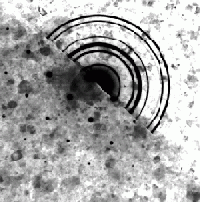SPI Supplies Brand Sodium Chloride Substrate, 12.5mm square x 1 mm thick, Pack of 5
Formula:NaCl
Appearance:Clear (nearly transparent)
single crystal plates
Odor:None
CAS #:7647-14-5
Density:2.165 g/cm3
12.5 mm square x 1 mm thick
Grow Epitaxial Films
These high quality research grade pre-cleaved sodium chloride single crystal substrates offer a major advantage: the ability to grow epitaxial films on a featureless substrate. But the cleaving of a larger sodium chloride "block" into substrates of the desired size, while not all that difficult, if it is not the kind of thing done on a regular basis, the "art" in doing it gets lost. And consequently, there are some who prefer to have SPI Supplies do the cleaving for them. If you are one who wants to do their own cleaving from larger NaCl blocks, then consider the the purchase of our single crystal cubes.
The orientation of the film ultimately grown on the substrate surface is related to the orientation of the substrate, producing areas of epitaxially grown single crystal film. This characteristic is ideal for boundary diffusion studies and applications where a single crystal thin film is required. The film is easily removed by floating it off on water or by dissolving away the underlying substrate.
The micrograph to the right shows a 30µm masked copper film grown epitaxially on a heated (300°C) single crystal NaCl substrate. The film was then overlaid with a 60µm film of aluminum. The single crystal diffraction pattern is from Cu9AI4 a compound formed at the boundary after annealing.
Bulk characterization of the single crystal substrate material has been performed, but only the most optically transparent material is selected. The major contaminant is CaSO4 with trace amounts of CaCl2, MgCl2, some "insoluble impurities" of unknown composition and moisture.
Spin coating:
The SPI Supplies Brand of Pre-Cleaved Sodium Chloride Substrates are suitable for processing via spin coating. The KW-4A Spin Coater is an ideal inexpensive table-top spin coater for use with sodium chloride substrates.
Statement of purity:
Some of these rock salt crystals may have regions where a visible variation in transparency (haziness) is apparent. The most common visible defects, and the source of this haziness, are inclusions (i.e., air bubbles) that were incorporated into the crystals during crystal growth. This is a very difficult problem to eliminate without an enormous (and to most users, an unacceptable) increase in the cost of these crystals. To compensate for this cosmetic flaw, most crystals are supplied with a volume greater than listed (> 1 cm3 or > 1 in3) to allow the customer to find regions that are free of these (bubble) inclusions. All supplied crystals provide at least the volume of defect-free single crystal specified, and in most cases, a larger volume. Visual inspection is usually adequate to find regions of the crystals which are relatively free of these defects.
Chemical analysis:
NaCl 99.9%
CaSO4 < 0.1%
CaCl2 < 0.01%
MgCl2 < 0.01%
Moisture < 0.01%
Historically, any concerns about "quality" usually result from appearance (visible small voids or crystalline defects) or from smell (sulfate released from voids when the crystals are cleaved.
Expected surface roughness:
A cleaved surface of the SPI single crystal NaCl cubes that is cleaved properly is atomically flat. We do endeavor to provide our customers with atomically smooth and flat surfaces when the pre-cleaved substrates are purchased. However, most cleaved samples do contain at least a few series of cleavage steps. Here, the surface is atomically flat over an area, then steps up one or more atomic planes followed by another atomically flat area, etc.
High temperature characteristics:
NaCl melts at 801° C (1474° F), so that obviously has to be the uppermost limit for use. Actually, the upper limit is lower than that, probably more like around 600° C (1112° F). We would expect that 600°C would be "safe", but this is not based on hard data. We would expect that any impurities that could be present in the crystals might off-gas before 600°C so if one is attempting such high temperature work, any loss of vacuum should not necessarily be interpreted that the upper limit at which this product could be used would have been breached.


